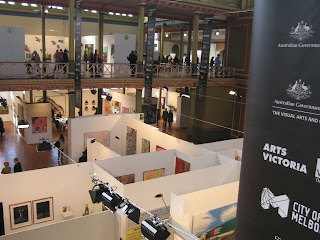So.....
Here's some behind the scenes of the works we made, and the finished installations (a small selection of them, we ended up making quite a lot, and I haven't gotten the professional photos back yet, so they are just snappy snaps)
I didn't go with simple, easy to make free-form crochet like I spoke of in March... I went for casting, sculpting, learning and inventing totally new things and combinations of materials that I'd never worked with before.
I have vowed for the next body of work to utilise my skills, not spend all my time figuring out how to make things work......
This is one of the two Hypohued Oculate Anemones I produced with the help of Tom. This one is as yet nude!
Tom is being a great collaborator and casting the base!
This is the finished piece. It's not that great a shot, I feel I'll have to explain it:
The glass polyps have been sheathed in machine knitted tubes which have been knitted from embroidery threads, so each tube is a combination of three to five different coloured fine threads, so it produces subtle (in hot pink) variations of tone, and you are able to glimpse the glass underneath.
In short, the eleven glass pieces that needed dressing, plus the base, plus the gluing and stitching took a long time. It was hard to juggle making all the other work, the writing, travelling for another show and parenting, and to top it all off, I made this piece to go specifically in a vertical drawer, like a hidden treasure surprise, I thought it was a great idea at the time, but with half the people I sent to see the show not finding it, I wish I'd made something out of cardboard that took me no time to put in that drawer!
Each piece has it's own fake museum labels and story attached to it, here's the anemone's:
This anemone colony is remarkable in that the polyps have developed
completely discrete functions that act independently of one another. There are often several eye stalks, feeding mouths and defensive wings that make up the whole anemone.
The Hypohued Oculate Anemone uses colour as a way to
attract small prey and bigger interest. It uses electrical pulses
throughout the polyps to change it’s appearance, being able to
react to various different stimuli and environments.
They are also able to communicate with other colonies
through colour patterns and flashing displays.
Excerpt from Laurosto journal:
….I was diving, and was entranced by this underwater delight,
until I reached out and it bit me.
Now I have two lovely specimens for my collection….
it did take a few attempts to capture a complete colony,
but the polyps look good with my jellyfish…
Location and dates unknown
Donated Laurosto Collection 2010 LSRHTM274

These are the Egyptian/Australian animal mummies. Here's the spiel for them:
An Interesting Connection
There have been a lot of theories about Ancient Egyptian sailors
reaching other continents, yet there has been little evidence to date.
Now, for the first time there is a definitive link between Ancient Egyptians and Australia in the form of a tomb discovered by Sam Laurosto, the intrepid amateur naturalist and collector.
The date of discovery as well as the exact location is shrouded in mystery, though we know it was somewhere in South Australia and some time in the late 1800’s.
Laurosto discovered in the tomb mummified native Australian animals, objects and frescoes that led him to believe that a small population of Ancient Egyptians resided in Australia for some time and integrated the local fauna into their existing pantheon.
He observed the similarities between the animals worshipped as anthropomorphic gods:
The Jackal headed God Anubis and the Kangaroo God (name unknown),
The Falcon headed God Horus and the Parakeet God,
and the Ibis headed God Thoth and the Brolga God.
He also noted that the Ancient Egyptians had a crocodile headed god, Sobek, and Australia is known for its crocodiles.

They gave us a poster on North Terrace (which is the main drag for the Art Gallery, Museum, State Library etc), notice Xi doesn't look that impressed.

Here's Lauren working on some finishing touches to the foyer display. We've a teaser selection of curios: a Spanish Man of Peace, an eye catching mineral Disconite, a blue hypohued anemone, an Egyptian Kangaroo head with sketches and various glassy sea creatures.

Here's a view of the mineral display with Laurosto's minerals added in. Tom made one called Turdite, found in Deep Craek. He was pretty pleased with that one,

and Lauren made Pompomnite which really doesn't look that different from the authentic green gypsum, but a whole bunch of school kids came through as we were checking out the display and had a great time debunking some of our minerals (but not all surprisingly enough!)

Amongst the sharks and deep sea fishes lurks the elusive many eyed Roller Fish.

And here we are finished installing on a project that we first started talking about when I was four months pregnant and lasted until.........well, actually, it's just been installed at the Adelaide Town Hall, so really, it's lasted until after our son's first birthday.
So thanks Lauren and Tom it was a great and interesting experience doing the show with you, (and Xi especially for getting dragged to the Museum so many times when you would have rather been laying on the grass!)




 This is a photorealistic, yet distorted perspective supersized sculpture that messed with your head. ......I can not remember the name of the artist (bad bad me!)
This is a photorealistic, yet distorted perspective supersized sculpture that messed with your head. ......I can not remember the name of the artist (bad bad me!)
















